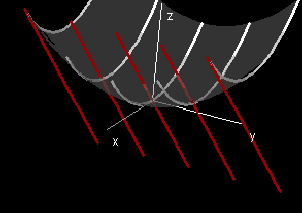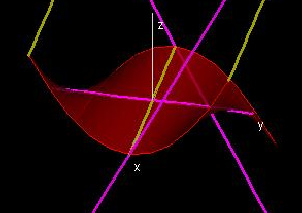|
Second Partial Derivatives
Text
A second partial derivative is a partial derivative of a function which is itself a partial derivative of another function.
 For example, one could take the partial derivative of some function f(x,y) with respect to x, and then take the partial derivative of the resulting function fx(x,y) with respect to y, generating the function fyx(x,y).
For example, one could take the partial derivative of some function f(x,y) with respect to x, and then take the partial derivative of the resulting function fx(x,y) with respect to y, generating the function fyx(x,y).

There are four types of second partial derivatives:

1. fxx(x,y) = Partial derivative of fx(x,y) with respect to x.
2. fyx(x,y) = Partial derivative of fx(x,y) with respect to y.
3. fxy(x,y) = Partial derivative of fy(x,y) with respect to x.
4. fyy(x,y) = Partial derivative of fy(x,y) with respect to y.

Third, fourth, fifth, and in general, nth partial derivatives for any positive integer n, exist as well.
 This is because the progression from first to second partial derivatives can be continued in the same way indefinitely. For example, to get fxyxy(x,y), take the partial derivative of fxy(x,y) with respect to y, and then take the partial derivative of the result with respect to x.
This is because the progression from first to second partial derivatives can be continued in the same way indefinitely. For example, to get fxyxy(x,y), take the partial derivative of fxy(x,y) with respect to y, and then take the partial derivative of the result with respect to x.

Demos
Second Partial Derivatives

| 
|
In the demo, the gray surface is the graph of f(x,y). If you check one of the partial derivative checkboxes ("f_x" or "f_y") you will be shown a graph of that partial derivative in the "First Partial Derivatives" window as well as a series of curves in the "Function Graph" window. The white curves are slices of the function graph, and the red or green curves show the values of the partial derivative for those slices of the surface. This shows how partial derivatives for functions of two variables relate to derivatives in one-variable calculus.
There are also four checkboxes for second partial derivatives. You can use these to view the surface for any of the second partial derivative functions as well as slice curves of the first partial derivative graph and curves showing the second partial derivative at those slices. This demonstrates that once you know how to find partial derivatives, you can easily find the second partial derivative by taking the partial derivative of a function which is itself a partial derivative of another function.
The second partial derivative graphs are colored as follows:
Yellow = fxx(x,y)
Magenta = fyx(x,y)
Blue = fxy(x,y)
Cyan = fyy(x,y)

|
Second Partial Derivatives

| 
|
This demo shows a function graph and its first and second partial derivatives as in the previous demo, but allows you to view each surface in a separate window. 
|
Exercises 1. Try entering each of these expressions for f(x,y). Note how the graphs of the second partial derivatives relate to the curvature of the graph of f(x,y):
- 0
- 1
- Any constant
- x
- x^2/2
- y
- y^2/2
- x^2-y^2 (saddle)
- –x^2 - y^4+y^2 (twin peaks)
- xy
- x^2/2+y^2/2+xy
- x^2*y^2
2. For polynomial functions of two variables, what are the conditions needed to yield a nonzero value for each of the following?
- fxx(x,y)
- fyy(x,y)
- fxy(x,y)
- fyx(x,y)
3. a. For each of the functions in part (1), what can you say about the relationship between the mixed partials (fxy(x,y) and fyx(x,y))?
b. Now enter the function f(x,y) = 4xy * (x^2 – y^2)/(x^2 + y^2) in the second demo. Look at the curves on the first partial derivative graphs which display the second derivatives. Are any of the second partial derivatives defined at (x,y) = (0,0)? How does this differ from your observations in part (a)? (This is discussed further in the lab on equality of mixed partials.)
|